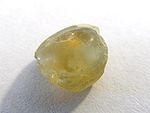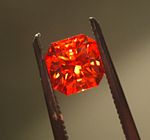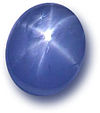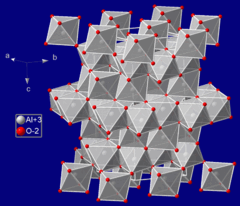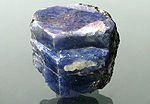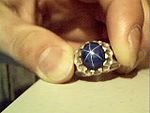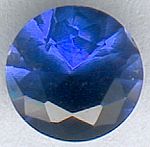- Sapphire
-
For other uses, see Sapphire (disambiguation).
Sapphire 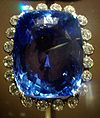
The 423-carat (85 g) blue Logan sapphireGeneral Category Oxide mineral Chemical formula aluminium oxide, Al2O3 Identification Color Every color except for red – which is called a ruby – or pinkish-orange (the padparadscha) Crystal habit massive and granular Crystal system Trigonal
Symbol (32/m)
Space Group: R3cCleavage none Fracture conchoidal, splintery Mohs scale hardness 9.0 Luster vitreous Streak white Specific gravity 3.95–4.03 Optical properties Abbe number 72.2 Refractive index nω=1.768–1.772
nε=1.760–1.763,
Birefringence 0.008Pleochroism Strong Melting point 2030–2050 °C Fusibility infusible Solubility Insoluble Other characteristics coefficient of thermal expansion (5.0–6.6)×10−6/K Sapphire (Greek: σάπφειρος; sappheiros, "blue stone"[1]) is a gemstone variety of the mineral corundum, an aluminium oxide (α-Al2O3), when it is a color other than red or dark pink; in which case the gem would instead be called a ruby, considered to be a different gemstone. Trace amounts of other elements such as iron, titanium, or chromium can give corundum blue, yellow, pink, purple, orange, or greenish color. Pure chromium is the distinct impurity of rubies. However, a combination of e.g. chromium and titanium can give a sapphire a color distinct from red.
Sapphires are commonly worn as jewelry. Sapphires can be found naturally, by searching through certain sediments (due to their resistance to being eroded compared to softer stones), or rock formations, or they can be manufactured for industrial or decorative purposes in large crystal boules. Because of the remarkable hardness of sapphires (and of aluminum oxide in general), sapphires are used in some non-ornamental applications, including infrared optical components, such as in scientific instruments; high-durability windows (also used in scientific instruments); wristwatch crystals and movement bearings; and very thin electronic wafers, which are used as the insulating substrates of very special-purpose solid-state electronics (most of which are integrated circuits).
Contents
Natural sapphires
The sapphire is one of the two or three gem-varieties of corundum, with another one being the red or deep pink ruby. Although blue is their most well-known color, sapphires are made up of any color of corundum except for red. Sapphires may also be colorless, and they are also found in shades of gray and black.
The cost of natural sapphires varies depending on their color, clarity, size, cut, and overall quality – as well as their geographic origin. Significant sapphire deposits are found in Eastern Australia, Thailand, Sri Lanka, Madagascar, East Africa, and in North America in a few locations, such as at "Gem Mountain", and in or near the Missouri River in the region around Helena, Montana.[2] Sapphire and rubies are often found together in the same area, but one gem is usually more abundant.[3]
Blue sapphire
Color in gemstones breaks down into three components: hue, saturation, and tone. Hue is most commonly understood as the "color" of the gemstone. Saturation refers to the vividness or brightness or "colorfulness" of the hue, and tone is the lightness to darkness of the hue.[4] Blue sapphire exists in various mixtures of its primary (blue) and secondary hues, various tonal levels (shades) and at various levels of saturation (brightness).
Blue sapphires are evaluated based upon the purity of their primary hue. Purple, violet, and green are the most common secondary hues found in blue sapphires.[5] Violet and purple can contribute to the overall beauty of the color, while green is considered to be distinctly negative. Blue sapphires with up to 15% violet or purple are generally said to be of fine quality. Blue sapphires with any amount of green as a secondary hue are not considered to be fine quality. Gray is the normal saturation modifier or mask found in blue sapphires. Gray reduces the saturation or brightness of the hue and therefore has a distinctly negative effect.[5]
The color of fine blue sapphires can be described as a vivid medium dark violet to purplish blue where the primary blue hue is at least 85% and the secondary hue no more than 15% without the least admixture of a green secondary hue or a gray mask.[4]
The 423-carat (85 g) Logan sapphire in the National Museum of Natural History, in Washington, D.C., is one of the largest faceted gem-quality blue sapphires in existence.
Fancy color sapphire
Yellow and green sapphires are also commonly found. Pink sapphires deepen in color as the quantity of chromium increases. The deeper the pink color the higher their monetary value as long as the color is trending towards the red of rubies.
Sapphires also occur in shades of orange and brown, and colorless sapphires are sometimes used as diamond substitutes in jewelry. Padmaraga sapphires often draw higher prices than many of even the finest blue sapphires. Recently, more sapphires of this color have appeared on the market as a result of a new artificial treatment method that is called "lattice diffusion".[6]
Padmaraga
Padmaraga is a pink-orange corundum, with a low to medium saturation and light tone, originally being mined in Sri Lanka, but also found in deposits in Vietnam and Africa; Padmaraga sapphires are rare. The name derives from the Sinhalese word for lotus blossom. The rarest of all padmaragas is the totally natural variety, with no sign of treatment.[7]
Star sapphire
A star sapphire is a type of sapphire that exhibits a star-like phenomenon known as asterism. Star sapphires contain intersecting needle-like inclusions (often the mineral rutile, a mineral composed primarily of titanium dioxide[8]) that cause the appearance of a six-rayed "star"-shaped pattern when viewed with a single overhead light source.
The Black Star of Queensland is believed to be the largest star sapphire that has ever been mined, and it weighs 733 carats.[9] The Star of India (weighing 563.4 carats) is thought to be the second-largest star sapphire, and it is currently on display at the American Museum of Natural History in New York City. The 182-carat Star of Bombay, located in the National Museum of Natural History, in Washington, D.C., is an example of a blue star sapphire. The value of a star sapphire, however, depends not only on the weight of the stone but also the body color, visibility and intensity of the asterism.
Color change sapphire
A rare variety of sapphire, known as color change sapphire, exhibits different colors in different light. Color change sapphires are blue in outdoor light and purple under incandescent indoor light; they may also be pink in daylight to greenish under fluorescent light. Some stones shift color well and others only partially, in that some stones go from blue to bluish purple. While color change sapphires come from a variety of locations, the gem gravels of Tanzania is the main source.
Certain synthetic color-change sapphires are sold as “lab” or “synthetic” alexandrite, which is accurately called an alexandrite simulant (also called alexandrium) since the latter is actually a type of chrysoberyl—an entirely different substance whose pleochroism is different and much more pronounced than color-change corundum (sapphire).
Source of color
Rubies are corundum which contain chromium impurities that absorb yellow-green light and result in deeper ruby red color with increasing content.[10] Purple sapphires contain trace amounts of vanadium and come in a variety of shades. Corundum that contains ~0.01% of titanium is colorless. If trace amounts of iron are present, a very pale yellow to green color may be seen. If both titanium and iron impurities are present together, however, the result is a magnificent deep-blue color.[11]
Unlike localized ("interatomic") absorption of light which causes color for chromium and vanadium impurities, blue color in sapphires comes from intervalence charge transfer, which is the transfer of an electron from one transition-metal ion to another via the conduction or valence band. The iron can take the form Fe2+ or Fe3+, while titanium generally takes the form Ti4+. If Fe2+ and Ti4+ ions are substituted for Al3+, localized areas of charge imbalance are created. An electron transfer from Fe2+ and Ti4+ can cause a change in the valence state of both. Because of the valence change there is a specific change in energy for the electron, and electromagnetic energy is absorbed. The wavelength of the energy absorbed corresponds to yellow light. When this light is subtracted from incident white light, the complementary color blue results. Sometimes when atomic spacing is different in different directions there is resulting blue-green dichroism.
Intervalence charge transfer is a process that produces a strong colored appearance at a low percentage of impurity. While at least 1% chromium must be present in corundum before the deep red ruby color is seen, sapphire blue is apparent with the presence of only 0.01% of titanium and iron.
Treatments
Sapphires may be treated by several methods to enhance and improve their clarity and color.[12] It is common practice to heat natural sapphires to improve or enhance color. This is done by heating the sapphires in air to temperatures between 500 and 1800 °C for several hours, or by heating in a nitrogen-deficient atmosphere oven for seven days or more. Upon heating, the stone becomes a more blue in color but loses some of the rutile inclusions (silk). When high heat temperatures are used, the stone loses all of the silk and becomes clear under magnification.[13] Evidence of sapphire and other gemstones being subjected to heating goes back to, at least, Roman times.[14] Un-heated stones are quite rare and will often be sold accompanied by a certificate from an independent gemological laboratory attesting to "no evidence of heat treatment".
Diffusion treatments are somewhat more controversial as they are used to add elements to the sapphire for the purpose of improving colors. Typically beryllium is diffused into a sapphire with very high heat, just below the melting point of the sapphire. Initially (c. 2000) orange sapphires were created with this process, although now the process has been advanced and many colors of sapphire are often treated with beryllium. It is unethical to sell beryllium-treated sapphires without disclosure, and the price should be much lower than a natural gem or one that has been enhanced by heat alone.
Treating stones with surface diffusion is generally frowned upon because when stones chip or are repolished/refaceted the 'padparadscha' colored layer can be removed. (There are some diffusion treated stones in which the color goes much deeper than the surface, however.) The problem lies in the fact that treated padparadschas are at times very difficult to detect, and they are the reason that getting a certificate from a reputable gemological lab (e.g., Gubelin, SSEF, AGTA, etc.) is recommended before investing in them.
According to Federal Trade Commission guidelines, in the United States, disclosure is required of any mode of enhancement that has a significant effect on the gem's value.[15]
Mining
Sapphires are mined from alluvial deposits or from primary underground workings. The mining locations include Burma, Madagascar, Sri Lanka, Australia, Thailand, India, Pakistan, Afghanistan, Tanzania, Kenya, and China. The Logan sapphire, the Star of India, and the Star of Bombay originate from Sri Lankan mines. Madagascar is the world leader in sapphire production (as of 2007) specifically its deposits in and around the city of Ilakaka.[16] Prior to the opening of the Ilakaka mines, Australia was the largest producer of sapphires (such as in 1987).[17] In 1991, a new source of sapphires was discovered in Andranondambo, southern Madagascar. That area has been exploited for its sapphires started in 1993, but it was practically abandoned just a few years later – because of the difficulties in recovering sapphires in their bedrock.[18]
In North America, sapphires have been mined mostly from deposits in Montana: fancies along the Missouri River near Helena, Montana, Dry Cottonwood Creek near Missoula, Montana, and Rock Creek near Philipsburg, Montana. Fine blue Yogo sapphires are found at Yogo Gulch west of Lewistown, Montana.[19][20] A few gem-grade sapphires and rubies have also been found in the area of Franklin, N.C.
The sapphire deposits of Kashmir are still well-known in the gem industry,[21] despite the fact that the peak production from this area mostly took place in a relatively short period at the end of the 19th and early 20th centuries.[22]
Synthetic sapphire
In 1902, the French chemist Auguste Verneuil developed a process for producing synthetic sapphire crystals.[23] In the Verneuil process, named for him, fine alumina powder is added to an oxyhydrogen flame, and this is directed downward against a mantle.[24] The alumina in the flame is slowly deposited, creating a teardrop shaped "boule" of sapphire material. Chemical dopants can be added to create artificial versions of the ruby, and all the other natural colors of sapphire, and in addition, other colors never seen in geology. Artificial sapphire material is identical to natural sapphire, except it can be made without the flaws that are found in natural stones. The disadvantage of Verneuil process is that the grown crystals have high internal strains. Many methods of manufacturing sapphire today are variations of the Czochralski process, which was invented in 1916.[25] In this process, a tiny sapphire seed crystal is dipped into a crucible made of the precious metal rhodium,[26] containing molten alumina, and then slowly withdrawn upward at a rate of one to 100 mm per hour. The alumina crystallizes on the end, creating long carrot-shaped boules of large size, up to 400 mm in diameter and weighing almost 500 kg.[27]
Synthetic sapphire is industrially produced from agglomerated aluminum oxide, sintered and fused in an inert atmosphere (hot isostatic pressing for example), yielding a transparent polycrystalline product, slightly porous, or with more traditional methods such as Verneuil, Czochralski, flux method, etc., yielding a single crystal sapphire material which is non-porous and should be relieved of its internal stress.
In 2003, the world's production of synthetic sapphire was 250 tons (1.25 × 109 carats), mostly by the United States and Russia.[27][28] The availability of cheap synthetic sapphire unlocked many industrial uses for this unique material:
The first laser was made with a rod of synthetic ruby. Titanium-sapphire lasers are popular due to their relatively rare capacity to be tuned to various wavelengths in the red and near-infrared region of the electromagnetic spectrum. They can also be easily mode-locked. In these lasers, a synthetically produced sapphire crystal with chromium or titanium impurities is irradiated with intense light from a special lamp, or another laser, to create stimulated emission.
Transparent and tough
One application of synthetic sapphire is sapphire glass. Here glass is a layman term which refers not to the amorphous state, but to the transparency. Sapphire is not only highly transparent to wavelengths of light between 170 nm (UV) and 5300 nm (IR) (the human eye can discern wavelengths from about 380 nm to 750 nm[29]), but it is also five times stronger than glass and ranks a 9 on the Mohs Scale, and much tougher than tempered glass, although not as much as synthetic stabilized zirconium oxide (such as yttria-stabilized zirconia). Along with zirconia and aluminium oxynitride, synthetic sapphire is used for shatter resistant windows in armored vehicles and various military body armor suits, in association with composites.
Sapphire "glass" (although being crystalline) is made from pure sapphire boules by slicing off and polishing thin wafers. Sapphire glass windows are used in high pressure chambers for spectroscopy, crystals in high quality watches, and windows in grocery store barcode scanners since the material's exceptional hardness and toughness makes it very resistant to scratching.[27]
One type of xenon arc lamp (originally called the "Cermax" its first brand name), which is now known generically as the "ceramic body xenon lamp", uses sapphire crystal output windows that tolerate higher thermal loads – and thus higher output powers when compared with conventional Xe lamps with pure silica window.[30]
Use as substrate for semiconducting circuits
Thin sapphire wafers are also used as an insulating substrate in high-power, high-frequency CMOS integrated circuits. This type of IC is called a silicon on sapphire or "SOS" chip. These are especially useful for high-power radio-frequency (RF) applications such as those found in cellular telephones, police car and fire truck radios, and satellite communication systems. "SOS" allows for the monolithic integration of both digital and analog circuitry all on one IC chip.
The reason for choosing wafers of artificial sapphire, rather than some of other substance, for these substrates is that sapphire has a quite low conductivity for electricity, but a much-higher conductivity for heat. Thus, sapphire provides good electrical insulation, while at the same time doing a good job at helping to conduct away the significant heat that is generated in all operating integrated circuits. Thus, the choice of sapphire material for these substrates was not an arbitrary one, but rather, it is a choice that is made for serious electronics engineering reasons.
Once the single crystal sapphire boules are grown they are cored-sliced into cylindrical pieces. Wafers are then sliced from these cylindrical cores. These Wafers of single-crystal sapphire material are also used in the semiconductor industry as a non-conducting substrate for the growth of devices based on gallium nitride (GaN). The use of the sapphire material significantly reduces the cost, because this has about one-seventh the cost of germanium. Gallium nitride on sapphire is commonly used in blue light-emitting diodes (LEDs).[31]
Historical and cultural references
- Etymologically, the English word “sapphire” derives from Latin sapphirus, sappirus from Greek σαπφειρος (sappheiros) from Hebrew סַפִּיר (sappir) from Old Iranian sani-prijam, from Sanskrit, ' 'Shanipriya' ' (शनिप्रिय), from "shani" (शनि) meaning "Saturn" and "priya" (प्रिय), precious or dear, i.e. "precious to Saturn" or literally “dear to Saturn”.
- The Greek term for sapphire quite likely was misapplied, and instead used to refer to lapis lazuli.
- During the Medieval Ages, European lapidaries came to refer to blue corundum crystal by its “sapphire-blue” color, whence the modern name for “sapphire”.[citation needed]
See also
References
- ^ Harper, Douglas. "sapphire". Online Etymology Dictionary. http://www.etymonline.com/index.php?term=sapphire.
- ^ Wise, pp. 164–166
- ^ Wenk, Hans-Rudolf; Bulakh, A. G. (2004). Minerals: their constitution and origin. Cambridge, U.K.: Cambridge University Press. pp. 539–541. ISBN 0-521-52958-1. http://books.google.com/?id=0GAvKQJ2JuwC&pg=RA1-PA539.
- ^ a b Wise, pp. 18–22
- ^ a b Wise, Chapter 22
- ^ Arthur Thomas (2008). Gemstones: properties, identification and use. New Holland Publishers. p. 226. ISBN 1845376021. http://books.google.com/?id=MPZK8ILOSR0C&pg=PA226.
- ^ Richard W. Hughes (1997), Ruby & Sapphire, Boulder, CO, RWH Publishing, ISBN 978-0964509764
- ^ Emsley, John (2001). Nature's Building Blocks: An A-Z Guide to the Elements. Oxford: Oxford University Press. pp. 451–53. ISBN 0-19-850341-5.
- ^ Kim, Victoria (5 January 2010). "For some, a sapphire has not been their best friend". Los Angeles Times. http://www.latimes.com/news/local/la-me-blacksapphire5-2010jan05,0,872801.story. Retrieved 5 jan 2010.
- ^ "Ruby: causes of color". http://www.webexhibits.org/causesofcolor/6AA.html. Retrieved 15 may 2009.
- ^ "Blue Saphire". http://www.webexhibits.org/causesofcolor/8.html. Retrieved 21 march 2010.
- ^ Wise, p. 169
- ^ "Identification of heated / unheated status on ruby and sapphire". http://www.gaaj-zenhokyo.co.jp/researchroom/corundum/heat-treatment_01en.html. Retrieved 21 March 2010.
- ^ Nassau, Kurt (1984). Gemstone Enhancement. Butterworths. p. 95. ISBN 0408014474.
- ^ Chapter I of Title 16 of the Code of Federal Regulations Part 23, Guides for Jewelry and Precious Metals and Pewter Industries
- ^ lakaka gem deposit, Ilakaka Commune, Ranohira District, Horombe Region, Fianarantsoa Province, Madagascar
- ^ Doug Cocks (1992). Use with care: managing Australia's natural resources in the twenty-first century. UNSW Press. p. 102. ISBN 0868403083. http://books.google.com/?id=auXS_gLKFjUC&pg=PA102.
- ^ Andranondambo
- ^ "Montana Sapphires - Gemology". Gem Gallery. http://www.gemgallery.com/#montana_sapphire_gemology. Retrieved October 29, 2011. Note: Includes map of major Montana sapphire mines
- ^ Voynick, Stephen M. (1985). Yogo The Great American Sapphire (March 1995 printing, 1987 ed.). Missoula, MT: Mountain Press Publishing. pp. 16-19. ISBN 0-87842-217-X.
- ^ Fact Sheets. Gia.edu. Retrieved on 2011-01-04.
- ^ GemResearch Swisslab (GRS) Specializing in Origin Determination of Fine Rubies and Sapphires. Gemresearch.ch. Retrieved on 2011-01-04.
- ^ M.A. Verneuil (September 1904) Memoire sur la reproduction artificielle du rubis per fusion, Annales de Chimie et de Physique
- ^ Heaton, Neal; The production and identification of artificial precious stones in Annual Report of the Board of Regents of the Smithsonian Institution, 1911. USA: Government Printing Office. 1912. p. 217. http://books.google.com/?id=hZIKAAAAIAAJ&pg=PA227.
- ^ Czochralski process
- ^ Nassau, K.; Broyer, A. M. (1962). "Application of Czochralski Crystal-Pulling Technique to High-Melting Oxides". Journal of the American Ceramic Society 45 (10): 474. doi:10.1111/j.1151-2916.1962.tb11037.x.
- ^ a b c Scheel, Hans Jr̲g; Fukuda, Tsuguo (2003) (PDF). Crystal growth technology. Chichester, West Sussex: J. Wiley. ISBN 0-471-49059-8. http://media.wiley.com/product_data/excerpt/98/04714905/0471490598.pdf.
- ^ Elena R. Dobrovinskaya, Leonid A. Lytvynov, Valerian Pishchik (2009). Sapphire: Materials, Manufacturing, Applications. Springer. p. 3. ISBN 0387856943. http://books.google.com/?id=IchDpFiLrGQC&pg=PA3.
- ^ Cecie Starr (2005). Biology: Concepts and Applications. Thomson Brooks/Cole. p. 94. ISBN 053446226X. http://books.google.com/?id=RtSpGV_Pl_0C&pg=PA94.
- ^ "Cermax lamp engineering guide". http://optoelectronics.perkinelmer.com/content/manuals/gde_cermax.pdf.
- ^ "Gallium nitride collector grid solar cell" (2002) U.S. Patent 6,447,938
- Wise, R. W. (2004). Secrets Of The Gem Trade, The Connoisseur's Guide To Precious Gemstones. Brunswick House Press. ISBN 097282238-0.
External links
- Webmineral.com, Webmineral Corundum Page, Webmineral with extensive crystallographic and mineralogical information on Corundum
- Farlang Sapphire References dozens of (historical) full text books and (CIBJO) gem information
- Mindat.org, Mindat Sapphire page Mindat with extensive locality information
- Sciencemag.org, Macroscopic 10-Terabit–per–Square-Inch Arrays from Block Copolymers with Lateral Order Science magazine article about perspective usage of sapphire in digital storage media technology
- Top Blue Sapphire Discovery
 "Sapphire". Encyclopædia Britannica (11th ed.). 1911.
"Sapphire". Encyclopædia Britannica (11th ed.). 1911.
Jewellery Forms Anklet · Belt buckle · Belly chain · Bindi · Bracelet · Brooch · Chatelaine · Collar pin · Crown · Cufflink · Earring · Lapel pin · Necklace · Pendant · Ring · Tiara · Tie clip · Toe ring · Watch (pocket)Making PeopleProcessesCasting (centrifugal, lost-wax, vacuum) · Enameling · Engraving · Filigree · Metal clay · Plating · Polishing · Repoussé and chasing · Soldering · Stonesetting · Wire wrappingToolsMaterials Precious metal alloysBritannia silver · Colored gold · Crown gold · Electrum · Platinum sterling · Shakudo · Shibuichi · Sterling silver · TumbagaMineral gemstonesAventurine · Agate · Alexandrite · Amethyst · Aquamarine · Carnelian · Citrine · Diamond · Diopside · Emerald · Garnet · Jade · Jasper · Lapis lazuli · Larimar · Malachite · Marcasite · Moonstone · Obsidian · Onyx · Opal · Peridot · Quartz · Ruby · Sapphire · Sodalite · Sunstone · Tanzanite · Tiger's eye · Topaz · Tourmaline · TurquoiseOrganic gemstonesTerms Categories:- Gemstones
- Oxide minerals
- Optical materials
- Dielectrics
- Transparent materials
- Aluminium minerals
- Superhard materials
- Trigonal minerals
Wikimedia Foundation. 2010.

